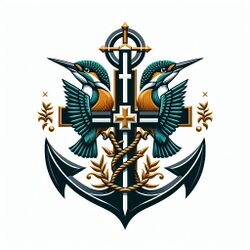Ultra Orthodox Battalions
| 7th, 15th, and 43rd Ultra-Orthodox Battalions | |
|---|---|
| 7eme, 15eme, and 43eme Batalions ultraortodoxes | |
 | |
| Active | 2003-present |
| Allegiance | |
| Branch | |
| Type | Mechanized infantry |
| Role | Counter terrorism, urban combat |
| Size | 3 independent battalions (~2,100 troops total) |
| Nickname(s) | Zion's Zealots the Militant militants |
| Motto(s) | Unto the glory of G-d/Allah |
| Engagements | |
| This article is part of a series on the |
| Burgoignesc Security Forces |
|---|
 |
| Military |
| Law Enforcement |
| Alliances and Cooperative Units |
| History and culture |
| Organization and Structure |
| Strategy and Defense Policies |
| Current Initiatives |
| Key Suppliers and Partnerships |
|
Burgundie portal |
The 7th, 15th, and 43rd Ultra-Orthodox Battalions of the Army of Burgundie’s Metropole Forces are three independent battalions that are typically grouped together in common discourse due to their expressed purpose of giving religious fanatics an opportunity to serve in the military while respecting the restrictions put inplace by their faith. Within the command structure of the Burgoignesc Security Forces they are typically grouped together due to their unique and similar logistical requirements.
History
Main article: Army of Burgundie
Ultra-Orthodox members of the Jewish faith in Burgundie have long resisted the Standardized Militia Program as it does not accommodate foundational tenants of their religious practice, Halakha. They often petition for alternatives to complete their one year of federal service. This practice was complicated by an archaic and arbitrary selection process that was costing the federal government millions of Thalers each year. In 1996 a council of male ultra-Orthodox high school seniors petitioned to have a military unit established that would enshrine the practices of their religion and allow them to serve with rabbinical dignity. Many ultra-Orthodox Rabbis amd parents resisted the idea as impossible. High school seniors petitioned again in 1997, 1998, and 2001 to no avail. In 2002 an experimental company level unit was formed. The unit was deemed a mild success despite violent protests in the ultra-Orthodox community and it was formally adopted in 2003. As the concept became more acceptable more and more ultra-Orthodox boys began opting to utilize the Standardized Militia Program for their federal service. In 2009, a second company was added. In 2011 the unit was granted battalion status. In 2012 a second battalion strength unit was formed for orthodox women. In 2023 a battalion strength unit was formed for ultra orthodox Muslims, two companies of Shia, two companies of Sunni, and a company of Wahabi adherents.
7th Battalion
15th Battalion
43rd Battalion
Special considerations
In adherence to the respective articles of faith utilized by ultra-orthodox faiths adjustments to the standard issue uniform and logistical requirements are necessary.
Food
To meet the Kosher and Halal requirements of the soldiers of the Ultra-Orthodox Battalions have trained staff in their supply chains and mess units. A single line of MREs are prepared for these units to meet both Kosher and Halal standards. When on campaign the 7th and 15th Battalions each have 3 Sachets on staff to slaughter animals. Mess units of all three units typically co-locate during deployments to facilitate efficient use of any fresh meat. Since the fore quarter of cattle or sheep is Kosher and the hindquarter are considered non-Kosher, but are Halal, meats are typically divied up in accordance with these laws. When deployed independently, the 7th and 15th Battalions will give the hindquarters to the secular units they are embedded with or to the locals, if their customs allow. Halal considers meat of rabbit, wild hens, shellfish, duck and goose as halal, but are not Kosher. Thus, when co-located these foods are not prepared at all. Halal considers the source of enzymes. If it comes from a non-Halal animal, it is prohibited. All enzymes, even from non-Kosher animals, are Kosher. As such, when co-located non-Halal enzymes are not prepared at all. All intoxicating alcohols, wines, liquors and drugs are prohibited in accordance with Halal. Kosher law allows all wines. When co-located wines must be imbibed in a closed off area so as not to offend those observing Halal. While in kosher foods, dairy and meat cannot be mixed and it is entirely prohibited, Halal permits the mixing of the two. While co-located mixing of dairy and meat is not permitted.
Prayer
Additional time is allotted in the non-combat work day for the various prayers that each group requires.
Uniforms
Since it is common for men in the 7th and 43rd Battalion to wear beards, gas masks are not a viable option for CBRN defense. As such, they are issued Positive pressure personnel suits which are widely understood to not be tactically useful as they are bulky, time consuming to don, and prone to tears in a combat situation.
Tzniut
Tzniut are religious laws in the Jewish faith pertaining to modesty and discretion. While not standard issue, wearing a Tallit katan is permitted under the battle dress uniform for men of the 7th Battalion and women of the 15th Battalion. Women of the 15th Battalion wear a standard issue mitpahat in the same pattern MultiCam as the battle dress uniform. It is knotted low in the rear so that a helmet can fit over it during combat. For men in the 7th Battalion, it is common for them to bring their own Tefillin for morning prayers as they are not issued. There is a standard issue kippot that is the same pattern MultiCam as the battle dress uniform. While not in combat, a standard issue forage cap is typically worn on top of the kippot.
Hijab
Hijab are religious laws in the Islamic faith pertaining to modesty and discretion. Men of the 43rd Battalion are issued MultiCam Taqiyah.